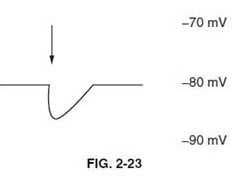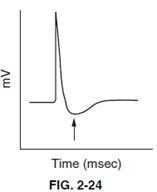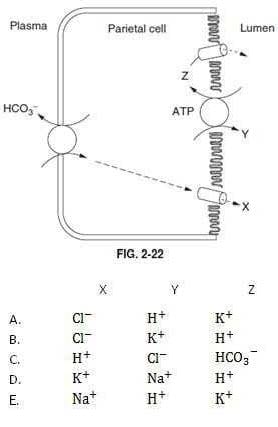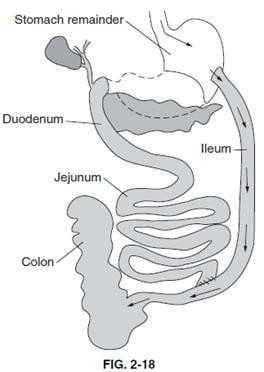Exam Details
Exam Code
:USMLE-STEP-1Exam Name
:United States Medical Licensing Step 1Certification
:USMLE CertificationsVendor
:USMLETotal Questions
:847 Q&AsLast Updated
:Apr 17, 2025
USMLE USMLE Certifications USMLE-STEP-1 Questions & Answers
-
Question 611:
Which of the following is a true statement regarding renal clearance of a substance?
A. is measured in milligram per minute
B. glucose is greater than that of insulin in the normal kidney
C. insulin is zero
D. PAH remains constant regardless of the plasma level
E. potassium clearance will increase after an injection of aldosterone
-
Question 612:
Heparin is a rapidly acting, potent anticoagulant that has many important clinical uses. Which of the following is an action of heparin?
A. activates prothrombin
B. acts with antithrombin to inhibit thrombin activity
C. decreases prothrombin time
D. inhibits calcium action
E. promotes vitamin K activity
-
Question 613:
Altered plasma renin levels can occur in both normal and pathologic conditions. Which of the following states is associated with a decrease in plasma renin levels?
A. heart failure
B. primary aldosteronism
C. renal artery stenosis
D. salt restriction
E. upright posture
-
Question 614:
Exhibit #1:

Exhibit #2:

Below figure shows the change in the membrane potential of a postsynaptic neuron caused by addition, at the arrow, of a neurotransmitter. The resting membrane potential of this cell is -80 mV. Relevant equilibrium potentials for +, , +, , and are, respectively, +120 mV, +60 mV,

0 mV, -80 mV, and -90 mV. This neurotransmitter likely increases the conductance of which of the following ions?
A. A
B. B
C. C
D. D
E. E
-
Question 615:
Below figure shows an intracellularly recorded action potential from a mammalian neuron. Which of the following statements is correct concerning events taking place at the point in time indicated by the arrow?

A. calcium conductance is higher than its normal resting level
B. chloride conductance is higher than its normal resting level
C. potassium conductance is higher than its normal resting level
D. sodium conductance is higher than its normal resting level
E. sodium-potassium ATPase activity is depressed
-
Question 616:
A patient presented with an acute abdomen including fever, marked abdominal distension, acidosis, and leukocytosis. Laparoscopy revealed that large parts of the small intestine were necrotic and as a consequence, the entire ileum of the patient was resected. It is expected that very soon after the surgery the patient will have considerable problems resulting from the malabsorption of which of the following?
A. iron
B. bile acids
C. sodium
D. vitamin
E. protein
-
Question 617:
below figure shows a gastric parietal cell with selected membrane transporters and channels. What do X, Y, and Z represent in the figure?

A. Option A
B. Option B
C. Option C
D. Option D
E. Option E
-
Question 618:
In patients with type 4 renal tubular acidosis (RTA) aldosterone deficiency is often a prominent finding. Distal tubular transport of which of the following ions will be affected in these patients?
A. hydrogen and potassium in exchange for sodium
B. hydrogen only
C. potassium only
D. sodium and bicarbonate
E. sodium only
-
Question 619:
Which of the following diseases will result in left ventricular hypertrophy?
A. Aortic valve stenosis
B. mitral valve stenosis
C. pulmonary valve regurgitation
D. tricuspid valve regurgitation
E. tricuspid valve stenosis
-
Question 620:
A 28-year-old, 166 cm (5.45 ft) tall woman, weighing 170 kg (375 lbs) successfully underwent biliopancreatic diversion surgery, in which a portion of her stomach was removed and the remaining portion of the stomach was connected to the lower portion of the small intestine (see below figure). What is her prevalence for peptic ulcer disease and for what reason?

A. it is higher due to inflammation caused by the surgical staples
B. it is higher due to the loss of secretin release
C. it is lower since chief cells were surgically resected
D. it is lower since G cells were surgically resected
E. it is unchanged since the surgery was successful
Tips on How to Prepare for the Exams
Nowadays, the certification exams become more and more important and required by more and more enterprises when applying for a job. But how to prepare for the exam effectively? How to prepare for the exam in a short time with less efforts? How to get a ideal result and how to find the most reliable resources? Here on Vcedump.com, you will find all the answers. Vcedump.com provide not only USMLE exam questions, answers and explanations but also complete assistance on your exam preparation and certification application. If you are confused on your USMLE-STEP-1 exam preparations and USMLE certification application, do not hesitate to visit our Vcedump.com to find your solutions here.